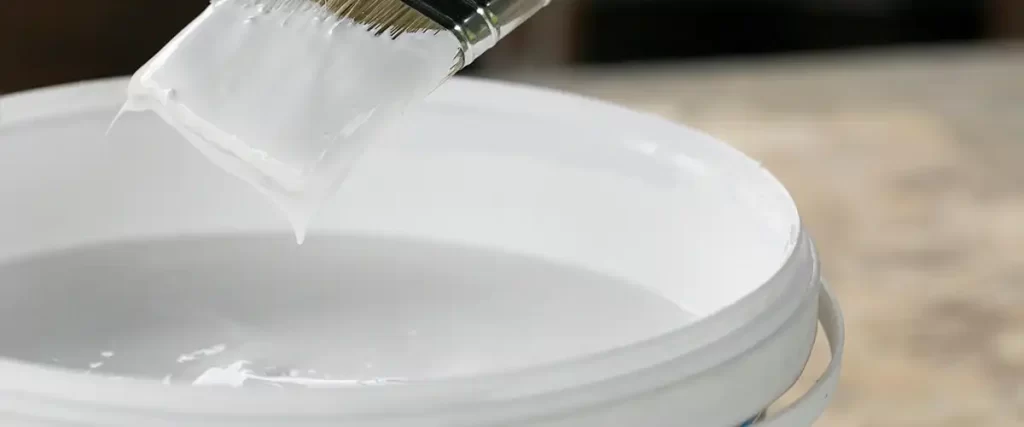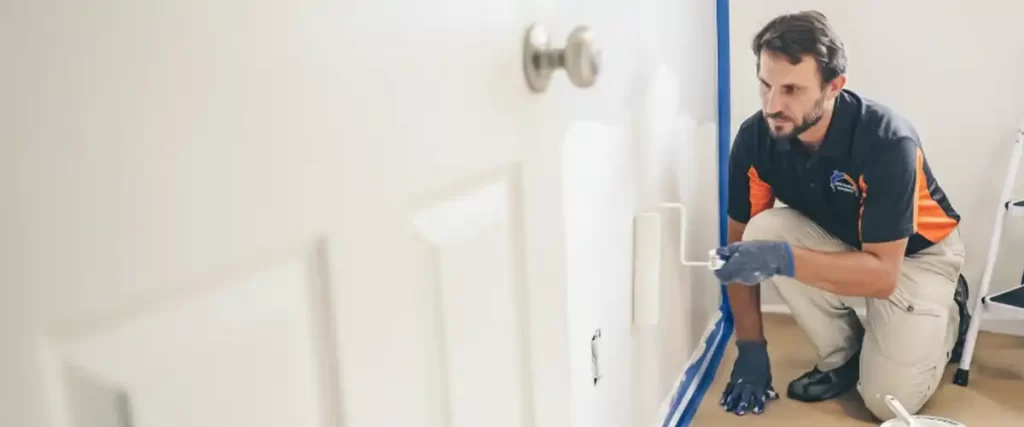When you think about painting your home, spring or summer probably comes to mind. But if you’re planning an interior project, especially in Wichita KS, winter might actually be the smartest time to do it.
The colder months offer a combination of stable indoor temperatures, dry air, and quieter schedules that make painting more efficient and less disruptive.
While it might not be the obvious choice, winter checks more boxes than most people realize.

Why Winter Works in Wichita
Winter conditions in Wichita create several advantages that make indoor painting smoother, faster, and more cost-effective.
1. Dry Air Helps Paint Cure Correctly
Wichita winters bring drier conditions, which helps paint dry and cure more evenly, but it’s important to aim for the ideal humidity level (typically 40-50%) for painting to ensure the best results.
Low humidity reduces the risk of tacky finishes, streaks, or bubbling. Those are the common problems when painting during humid conditions or periods of high humidity, which can cause issues like tacky finishes or bubbling.
2. Consistent Indoor Temperatures
Your heating system keeps the indoor climate stable, providing the ideal conditions, typically 65–75°F, for interior painting.
These temperatures support proper paint application and help ensure that paint adheres well to surfaces, allowing modern interior paints to perform at their best. Most cabinet and wall paints work best in 65–75°F environments, and winter heating keeps you right in that range.
3. Faster Project Timelines
Because the drying conditions are more stable and predictable in winter, you’ll often be able to apply multiple coats more efficiently. That means rooms can be painted and put back together quickly. Ideal if you’re trying to limit disruption.
Additionally, stable winter conditions help achieve optimal results for your paint job.
4. Easier Scheduling With Painting Professionals
Winter is a slower season for most painters, which means:
- Easier booking
- More flexible scheduling
- Potential off-season discounts or incentives
It also means more time and attention from your painting crew, fewer overlapping jobs, fewer delays. Painting contractors are often more available during winter and can dedicate more focus to your project, ensuring a higher quality outcome.
Interior Paint Brightens Winter Light
Shorter days and cloudy skies can make your home feel dim, especially if walls are dull or outdated.
New paint, especially when a quality paint job is done, can enhance the look and feel of your home. Reflective finishes like satin or semi-gloss can dramatically increase light bounce on the surface and lift the mood of a space.
Winter Color Ideas to Brighten Up:
- Soft Neutrals: Cream, warm white, greige
- Muted Pastels: Dusty blue, blush pink, sage
- Earthy Tones: Terracotta, soft clay, muted mustard
- High-Contrast Accents: Navy, charcoal, forest green
These tones work well in the natural light of winter and transition beautifully into spring and summer.

Free Up Spring for Outdoor Projects
Getting your indoor painting done in winter opens up your spring for outdoor upgrades and other warm-weather plans.
Spring painting is a popular time for tackling exteriors and applying exterior paint, as the weather is ideal for these projects.
After harsh winter weather, many surfaces may need to be repainted to maintain durability and curb appeal.
The summer season is also a busy period for exterior painting projects. Instead of juggling indoor renovations when the weather turns nice, you’re ready to move on to:
- Landscaping
- Exterior painting
- Deck repairs or staining
- Travel, family visits, or time outside
You’ll also beat the spring rush, when painters, handymen, and contractors start booking up quickly.
Address Interior Wear and Tear Before It Spreads
Winter is the best time of year to inspect and repaint walls with:
- Scuff marks
- Peeling paint
- Nail pops
- Faded or yellowed finishes
- Water-damaged ceiling surfaces, including stains or peeling paint
Touching up or repainting walls and repairing and painting water-damaged ceilings now prevents more costly repairs later. Like drywall damage, cracking, or water infiltration near windows, trim, and ceilings.
Most Manageable Time for Indoor Projects
Painting indoors during the colder months is more predictable and less disruptive than spring or summer projects.
Winter is also an ideal time to focus on interior jobs that are less affected by outdoor weather. You’re already spending more time at home, and many families find it easier to:
- Paint one room at a time
- Use flexible weekend schedules
- Manage cleanup without outdoor messes
Even if you’re only painting a single room, such as a bedroom, hallway, or office, the size of the space can affect how long the project takes. It also influences how you plan your work.
Still, winter painting often feels easier to fit into everyday life.

What Type of Paint Works Best in Winter?
For the best results when painting indoors in Wichita during winter, choose:
- Low- or Zero-VOC Paints: Safer for indoor air quality when ventilation is limited
- Acrylic Latex: Fast drying, low odor, and easy to clean
- Washable Finishes: Use satin or semi-gloss in kitchens, bathrooms, and high-traffic areas
- Avoid Oil-Based Paints: Longer dry times and stronger fumes, not ideal for cold months
Selecting the right paint type ensures it will adhere properly to surfaces, which is especially important for a durable and long-lasting finish.
Winter conditions can slow the time it takes for paint to dry due to lower temperatures and higher humidity, so choosing products designed for winter paint application helps manage drying times and finish quality.
These paints are made to perform in typical indoor winter conditions and reduce drying issues or odor buildup.
Achieving a Flawless Finish in Winter
Winter can be an ideal season for painting interiors, but it does come with its own set of challenges.
Thanks to lower humidity levels, water based paints are especially effective during winter painting projects They dry faster and are less likely to be affected by moisture in the air.
For the best results, apply multiple coats of paint, making sure each coat is completely dry before adding the next.
Budgeting and Cost Considerations
Keeping an eye on your budget is just as important as choosing the right colors.
Costs can vary depending on the size of your space, the quality of paint, and whether you hire professional painters or tackle the job yourself. Take advantage of seasonal promotions.
Many stores offer discounts on paint and supplies during the summer months, which can help you save on materials for your next project.
Hiring experienced painters can also be a smart investment, as they’ll ensure a flawless finish and efficient completion, often saving you time and reducing the risk of costly mistakes.

Choose Roll Call Painting for Winter Projects
If you’re ready to refresh your Wichita home while the weather is cold, our team at Roll Call Painting can help you take full advantage of the season with professional interior painting services. We specialize in interior repaints that are clean, efficient, and designed to last.
Here’s what we offer:
- Free in-person estimates
- Personalized color consultations
- High-end results with minimal disruption
- Use of premium low-VOC paints
- A 3-year workmanship warranty
Call us at (316)-800-6994 or request your estimate online to get started.
FAQs
What Is the Best Time to Paint House Interior Walls?
Winter is often the best time, especially when humidity is low and indoor temperatures are stable. You’ll also benefit from easier scheduling and faster drying times.
Can I Paint Indoors During Cold Weather?
Yes, as long as indoor temperatures stay between 60–75°F, you’re good to go. Avoid opening windows unless using low-VOC or zero-VOC paint to limit odor buildup. However, you should avoid painting if extreme cold causes indoor temperatures to drop below recommended levels, as this can negatively affect paint adhesion and drying.
How Often Should I Repaint Interior Walls?
Every 5–7 years for most rooms. High-traffic areas like kitchens, hallways, and bathrooms may need repainting every 3–5 years.
What’s the Best Time of Year to Paint Indoors for the Lowest Cost?
Winter is typically the most budget-friendly time to paint interiors due to off-season labor availability and paint promotions. Labor costs are often lower in the winter, as demand for professional painters decreases, but they may rise during peak seasons like spring and summer.
What is the worst time to paint indoors in Wichita?
The worst time to paint indoors in Wichita is during periods of extreme weather, such as very high humidity, freezing temperatures, or during a heatwave. These conditions can negatively impact paint drying, adhesion, and overall finish quality.
Should I paint on a windy day?
It’s best to avoid painting on a windy day. Strong winds can blow dust and debris onto wet paint, affect curing time, and may cause uneven drying or imperfections in the finish.
Is hot weather good for indoor painting?
Hot weather and summer heat can cause paint to dry too quickly, which may lead to poor adhesion and reduced durability. While warmer weather can help with faster drying and easier application, extreme heat indoors is not ideal. Early summer or mild warmer weather is preferable, but avoid painting during the peak of summer heat for the best results.
